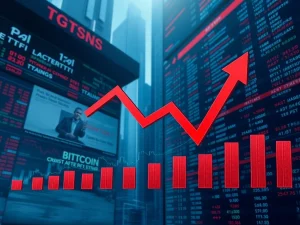Crucial EU Tariffs: Europe Unleashes €93 Billion Counter-Attack in Escalating US Trade War

In the volatile world of finance, every major geopolitical shift can send ripples across various asset classes, including the dynamic cryptocurrency market. As traditional financial markets brace for significant turbulence, understanding the latest developments in global trade disputes becomes crucial. The European Union and the United States are currently locked in a high-stakes standoff, with the EU announcing a massive €93 billion retaliatory measure against U.S. goods. This move directly responds to former President Donald Trump’s threat of a 15% tariff on EU exports, setting the stage for a potential full-blown US trade war that could reverberate through global markets.
The Brewing Storm: Understanding the Latest EU Tariffs
The air is thick with tension as the European Union confirms its readiness to impose significant retaliatory tariffs. Diplomatic sources indicate that EU member states are set to vote on tariffs targeting approximately €93 billion ($109 billion) worth of U.S. goods. If approved, these measures could be implemented as early as August 7th. This aggressive stance by the EU is a direct counter to the U.S. President’s proposed 15% tariff on EU exports, a move the bloc views as a clear violation of existing trade agreements.
The proposed EU tariffs are not arbitrary; they are strategically designed to hit key sectors of the U.S. economy. Industries such as aircraft manufacturing and whiskey production are specifically targeted, aiming to maximize pressure on the U.S. administration. This calibrated response seeks to balance deterrence with the slim possibility of compromise, as the EU strives to protect its vital industries while simultaneously trying to avert a devastating, full-scale trade conflict.
Key Aspects of the EU’s Retaliatory Strategy:
- Targeted Industries: Aircraft, whiskey, and other sectors critical to the U.S. economy.
- Financial Volume: Approximately €93 billion ($109 billion) in U.S. goods.
- Implementation Timeline: Potentially as early as August 7th.
- Political Unity: Strong backing from economic powerhouses like Germany and France.
Navigating the US Trade War: A High-Stakes Game
The current situation is a delicate dance of diplomacy and economic brinkmanship. Germany and France, two of the EU’s most influential members, have vocally advocated for a unified European front. Their message is clear: the U.S. must withdraw its tariff threats to prevent widespread economic disruption for both transatlantic partners. The EU’s strategy also includes provisions for exemption clauses on certain EU goods, hinting at a willingness to negotiate specific terms while retaining significant leverage through high-impact tariffs.
Analysts are keenly observing the strategic significance of the EU’s approach. What some are calling a “trade bazooka,” the potential for 30% tariffs on over $115 billion in U.S. goods, is clearly intended as a powerful bargaining chip. This tactic aims to compel the U.S. to accept a more palatable baseline tariff of 10%, a significant concession compared to Trump’s more aggressive 15% proposal. The EU’s readiness to implement these retaliatory measures by late August underscores the urgency with which it views the perceived imbalances in transatlantic trade relations.
The EU’s Negotiating Leverage:
The EU isn’t just reacting; it’s playing a strategic game:
- The “Trade Bazooka”: The threat of 30% tariffs on over $115 billion in U.S. goods serves as a powerful deterrent.
- Targeted Pain Points: Focusing on U.S. sectors like aerospace and spirits ensures maximum economic impact.
- Unified Front: Strong alignment from key member states like Germany and France bolsters the EU’s negotiating position.
- Flexibility with Leverage: The inclusion of exemption clauses signals a willingness to negotiate specific terms while maintaining the threat of high-impact tariffs.
Potential Fallout: How Global Markets Could React
The broader implications of this escalating trade dispute for global markets are a primary concern for investors worldwide. While the EU has reportedly prepared a €100 billion “no-deal plan” for a worst-case scenario, its simultaneous engagement in high-level negotiations clearly indicates a strong preference for a diplomatic resolution. The internal cohesion demonstrated by Germany and France aligning behind the EU’s strategy is a critical factor that could strengthen the bloc’s position at the negotiating table.
However, with an August 1st deadline looming for the U.S. to potentially enact its tariffs, the window for last-minute diplomacy is rapidly narrowing. This tight timeline raises significant concerns about a potential cycle of escalating tariffs that could destabilize global supply chains, impact commodity prices, and dampen investor confidence. For cryptocurrency markets, such instability in traditional finance often translates into increased volatility, as investors seek safe havens or re-evaluate risk exposures.
Impact on Global Trade and Investment:
A prolonged trade conflict could lead to:
- Supply Chain Disruptions: Tariffs increase costs and complexities for businesses reliant on international trade.
- Reduced Consumer Spending: Higher import costs can translate to increased prices for consumers.
- Investment Uncertainty: Businesses may delay expansion or investment plans due to unpredictable trade policies.
- Currency Fluctuations: Trade imbalances can impact currency valuations, affecting international transactions.
- Increased Volatility in Markets: Both traditional and crypto markets could experience heightened price swings as investors react to news.
Mitigating Economic Disruption: EU’s Strategic Play
The EU’s readiness to implement retaliatory measures by late August highlights its determination to address perceived imbalances in transatlantic trade. The inclusion of key U.S. industries in the retaliation list significantly amplifies the stakes for American exporters, making it harder for the Trump administration to ignore the potential fallout. This calculated aggression is designed to push the U.S. towards a more amicable resolution rather than a full-blown trade war.
The strategy is multi-faceted, aiming not just to retaliate but to create an environment conducive to future trade negotiations. By demonstrating its capacity for a robust response, the EU hopes to encourage the U.S. to de-escalate. The underlying goal is to protect European industries from unfair competition while ensuring the stability of global trade relations, which are vital for sustained economic growth.
The Path Forward: What’s Next for Trade Negotiations?
The outcome of these critical trade negotiations will undeniably shape the future of EU-U.S. trade relations for years to come. A successful compromise could solidify the EU’s role as a powerful counterbalance to U.S. protectionist policies, reinforcing the principles of multilateral trade and cooperation. Conversely, a breakdown in talks risks deepening the existing rift, potentially reshaping transatlantic trade dynamics in profound and lasting ways.
As the August 1st deadline approaches, all eyes remain on Brussels and Washington. The decisions made in the coming weeks will not only determine the immediate economic future for two of the world’s largest economies but also set a precedent for how international trade disputes are resolved in an increasingly interconnected and volatile world. For those monitoring global markets, this unfolding drama represents a key indicator of economic stability and geopolitical risk.
The implications of this trade standoff extend beyond traditional markets. The interconnectedness of the global economy means that significant shifts in trade policy can impact investor sentiment, liquidity, and risk appetite across all asset classes, including cryptocurrencies. While crypto markets often march to their own beat, major macroeconomic events like a transatlantic trade war can certainly introduce additional layers of volatility and uncertainty. Staying informed on these developments is key for navigating the broader financial landscape.
Frequently Asked Questions (FAQs)
1. What exactly are the proposed EU tariffs?
The EU is proposing retaliatory tariffs on approximately €93 billion ($109 billion) worth of U.S. goods. These tariffs are designed to counter a threatened 15% tariff on EU exports by the U.S. and would target key American sectors like aircraft and whiskey.
2. Why is the EU imposing these tariffs?
The EU views the U.S. threat of a 15% tariff as a breach of existing trade agreements and an aggressive protectionist policy. The proposed EU tariffs are a calibrated response aimed at deterring the U.S. and bringing them back to the negotiating table for a more balanced trade agreement.
3. Which U.S. industries will be most affected by the EU tariffs?
The primary U.S. industries targeted by the EU’s retaliatory tariffs include aircraft manufacturing and whiskey production. These sectors were chosen for their economic significance and ability to exert pressure on the U.S. administration.
4. What are the potential broader impacts on global markets?
A full-scale trade war could lead to significant global market instability, including disruptions to supply chains, increased costs for consumers, dampened investor confidence, and heightened volatility across various asset classes, including traditional stocks and cryptocurrencies.
5. Is a full-scale trade war inevitable?
While tensions are high and deadlines are approaching, a full-scale trade war is not inevitable. The EU’s strategy includes both aggressive tariff threats and simultaneous engagement in high-level negotiations, signaling a preference for a diplomatic resolution. However, the window for last-minute diplomacy is narrowing.
6. How might this US trade war impact cryptocurrency markets?
While not directly tied to trade tariffs, major geopolitical and economic events like a US trade war can significantly impact global investor sentiment. Increased uncertainty in traditional markets might lead some investors to seek alternative assets like cryptocurrencies, potentially increasing their volatility. Conversely, a broader economic downturn could also reduce overall investment capital, affecting all markets.









